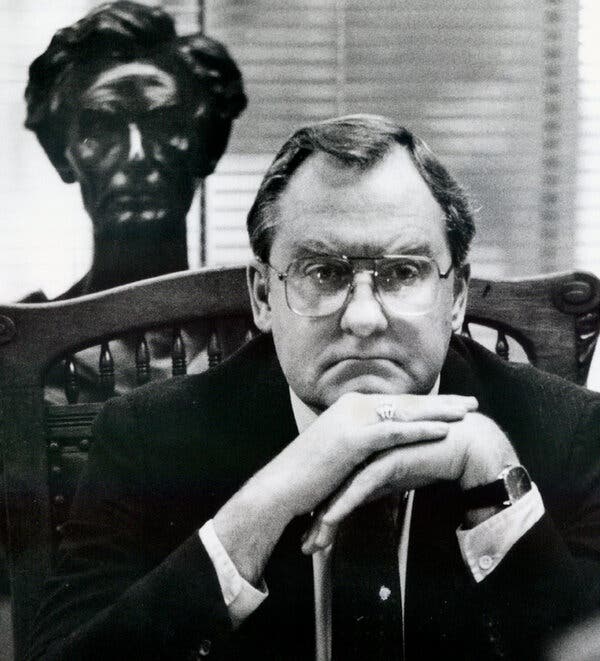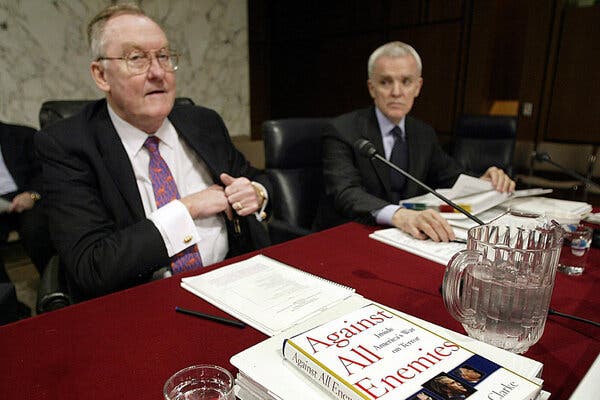Advertisement
A relentless campaigner, he served for 14 years after winning an election to a special two-year term in 1976.

James R. Thompson, a Republican known as Big Jim who used his enthusiasm for campaigning and his canny understanding of state politics to become the longest-serving governor of Illinois, died on Friday. He was 84.
His daughter, Samantha Thompson, confirmed his death. She said Mr. Thompson had been recovering from an undisclosed illness at Shirley Ryan AbilityLab in Chicago when his heart stopped.
On social media, Democrats and Republicans praised Mr. Thompson’s abilities as a politician who so enjoyed meeting with constituents that he would march parade routes twice, even in off-election years.
His relentless style of campaigning overwhelmed Democrats, who consistently failed to find an opponent who could beat Mr. Thompson, the first Republican endorsed for governor by the Illinois A.F.L.-C.I.O.
He served from 1977 to 1991.
“Try as we might, we Democrats just could not beat Big Jim,” Senator Dick Durbin, an Illinois Democrat, said on Twitter.
Mr. Durbin said he and Mr. Thompson “were political adversaries yet personal friends back in the day when that was not uncommon.”
David Axelrod, the former senior strategist for President Obama who covered Mr. Thompson as a governor when he was a reporter at The Chicago Tribune, described Mr. Thompson on Twitter as “one of the smartest and most formidable politicians I’ve ever known.”
In a statement, the Illinois governor, J.B. Pritzker, a Democrat, said Mr. Thompson would “be remembered and revered as one of the titans in the history of state government.”
James Robert Thompson was born on the West Side of Chicago on May 8, 1936. His father, also James Robert Thompson, worked as a morgue attendant while studying to become a doctor. His mother, Agnes Josephine Swanson, was a homemaker, Mr. Thompson said in a 2013 interview with the Abraham Lincoln Presidential Library.
He is survived by his wife, Jayne Carr Thompson, a retired lawyer; his daughter and his son-in-law, Anastasios Tomazos; and his granddaughter, Persephone.
Mr. Thompson was politically ambitious from an early age and signed his high school yearbook, “Jim Thompson, Pres. of U.S. 1984-1992.”
As U.S. attorney for the Northern District of Illinois, he prosecuted several prominent political figures, including Otto Kerner, a federal appeals judge who was convicted of accepting a bribe as governor. In 1976, Mr. Thompson won election to a special two-year term by the largest margin in state history, with more than 64 percent of the vote.
At 6 feet 6 inches, Mr. Thompson was physically imposing and proud of his height, once boasting that he was “the tallest governor” in the country.
Any candidate who tried to oppose him was overwhelmed by Mr. Thompson’s preparedness. His staff always had an updated briefing book listing recent news events in any county he visited, the names of prominent local people and their birthdays and his last visit there.
He would wear a different local team jacket each time on parade routes and would step out of the parade to sip a beer on an onlooker’s porch.
“He loved being governor,” Ms. Thompson, his daughter, said. “God, did he love being governor.”

A moderate Republican, Mr. Thompson pushed for a $2.3 billion project to rebuild the state’s infrastructure. Known as Build Illinois, it was a sprawling, ambitious project that aimed to expand highways, repair sewer lines, clean up toxic sites and fund college and university building projects.
An avid art collector, he created the Illinois Historic Preservation Agency and helped save the Dana-Thomas House in Springfield, which was designed by Frank Lloyd Wright.
Mr. Thompson was also credited with helping keep the White Sox in Chicago. In 1988, he worked with lawmakers to put together a deal to get the team a new stadium, preventing a potential move to Florida.
After he left office, he returned to the law and served as chairman of Winston & Strawn, a Chicago law firm. He served on the commission that investigated the Sept. 11, 2001, terrorist attacks. As a private lawyer, he helped defend former Gov. George Ryan during his federal corruption trial.
Ms. Thompson said the last time she had heard from her father was when he wrote a WhatsApp message commenting on a picture his wife had sent of Persephone.
“Beautiful,” he wrote.
She said her father had bemoaned the vitriolic state of political discourse in the country and the recent violence in Chicago.
“That was very hard for him,” Ms. Thompson said. “Because he loved people. He loved all kinds of people, and to see divisiveness in your country, in your city, is really hard.”


